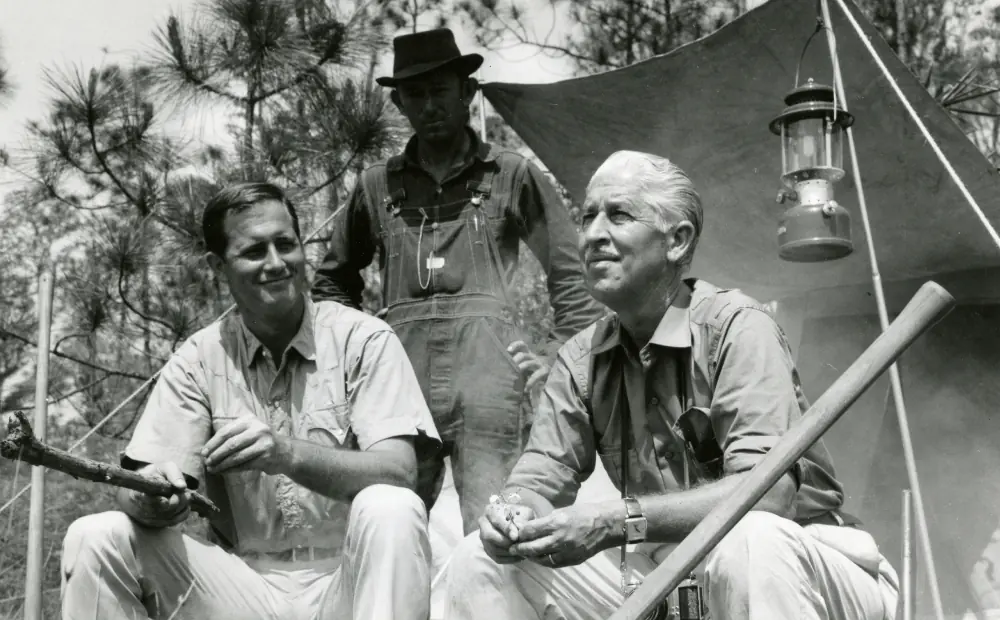0:05
Today we're at the Georgia Aquarium in Atlanta, GA.
0:09
We're behind this tank.
0:11
It has all kinds of things in it.
0:12
But the biggest thing in this tank?
0:15
Whale sharks.
0:16
Whale shark.
0:17
So many people think that whale sharks aren't whales.
0:21
We know they're actually a shark.
0:22
Yeah.
0:23
They get that name because of their size.
0:25
They're beautiful.
0:26
They have this almost chalky pattern on their bodies.
0:30
And they're found in these nice, warm tropical waters.
0:33
Whale sharks have a lot of threats.
0:35
Anything that threatens the oceans threatens whale sharks.
0:38
Fishing is a major threat.
0:40
Pollution is a major threat.
0:41
But now people realize what a calm, some sort of benign animals they are, and they want to go see them in the wild.
0:48
How is ecotourism affecting the behavior of whale sharks?
0:52
And what is the correct way to do it?
0:54
What is the balance?
0:55
So we're here today to learn all about the biology and the conservation of whale sharks.
1:00
And there goes one now along with ray, a manta ray, a different ray, different ray slightly.
1:10
The two whale sharks in human care here, Yushan and Taroko, not only provide education for visitors, but they're a vital resource for wild whale shark conservation.
1:21
We actually don't know as much about whale sharks as you might think.
1:24
They're a very difficult species to study.
1:27
So having whale sharks here gives us access to learn a lot about what they're eating and what does their behavior look like.
1:34
Whale sharks are like giant underwater vacuum cleaners.
1:39
They draw seawater into their 5 foot wide mouths, trapping small creatures in their gills.
1:45
The giant fish then swallows them all down.
1:49
Oh my God.
1:50
Whoa.
1:50
I had a chance to see this first hand during a feeding session with Senior Aquarist Tim McKay.
1:56
Oh that is so cool to be so close.
1:59
First facility that's ever done a full genome sequence on whale sharks, so we know they're full DNA sequence.
2:05
A lot of the techniques that we do, for instance, with our underwater blood draws, we are able to then use those techniques in the field to be able to study wild whale sharks.
2:16
Fishing Nets suspended from docks in Indonesia even gave researchers a unique opportunity to learn about wild whale sharks.
2:24
Whale sharks are often drawn to the docks for a free meal.
2:28
Locals usually help gently release them back into the water if they get stuck.
2:34
However, when Georgia Aquarium scientists were there, they had the chance to quickly perform measurements, take blood samples, and attach fin mounted satellite tags so the whale shark's movements could be tracked.
2:49
To see wild whale shark research for myself, I embarked on a nearly 900 mile journey S to the tip of the Yucatan Peninsula in Mexico.
3:00
There I met up with whale shark researchers Lucas Griffin, Rafael de la Para, and Lucas's dad, Kurt.
3:07
You must be Rafael.
3:08
Very nice to meet you.
3:09
Yes.
3:11
We cast off from a Marina in Cancun and set our sights on the largest gathering of whale sharks on the planet.
3:19
What makes this place so unique is all at least whale sharks have been across the Gulf of Mexico, the Caribbean Sea, maybe even down to Brazil.
3:29
That's what the previous satellite data has shown.
3:31
And so they all congregate here.
3:33
In the late summer months, whale sharks embark on epic migrations to reach their seasonal feeding grounds.
3:43
In the summer, Mexico is the place to be.
3:47
The sharks are drawn here by a feast of tiny eggs spawned in colossal numbers by a species of Atlantic tuna, a crucial source of food in the vast open ocean.
3:59
How did you ever get started on a whale shark project here?
4:02
Yeah, so it's bit of a funny story.
4:04
We came out here in 2013 just as a family vacation, and we went out to see the whale sharks.
4:09
But once we got out there, there were so many boats, snorkelers, also lots of whale sharks.
4:14
It kind of got chaotic.
4:15
And so we thought to ourselves, there might be a research project here.
4:20
As we navigated closer to the feeding grounds, we were joined by a growing Armada of tour vessels.
4:26
And soon we can see even more boats on the horizon.
4:31
We arrived to a chaotic scene.
4:34
Dozens of snorkelers were in the water, jostling alongside several graceful sharks.
4:40
This is undoubtedly a once in a lifetime educational opportunity for these tourists, but at what cost?
4:47
Is all this activity harming the sharks?
4:51
Well, that's exactly what we're here to find out.












